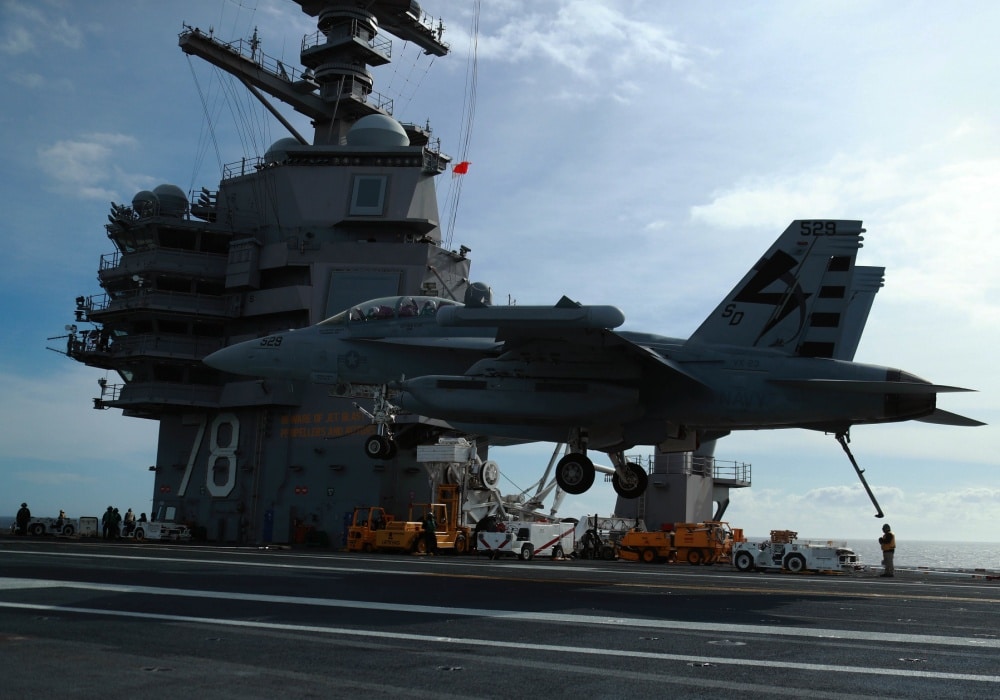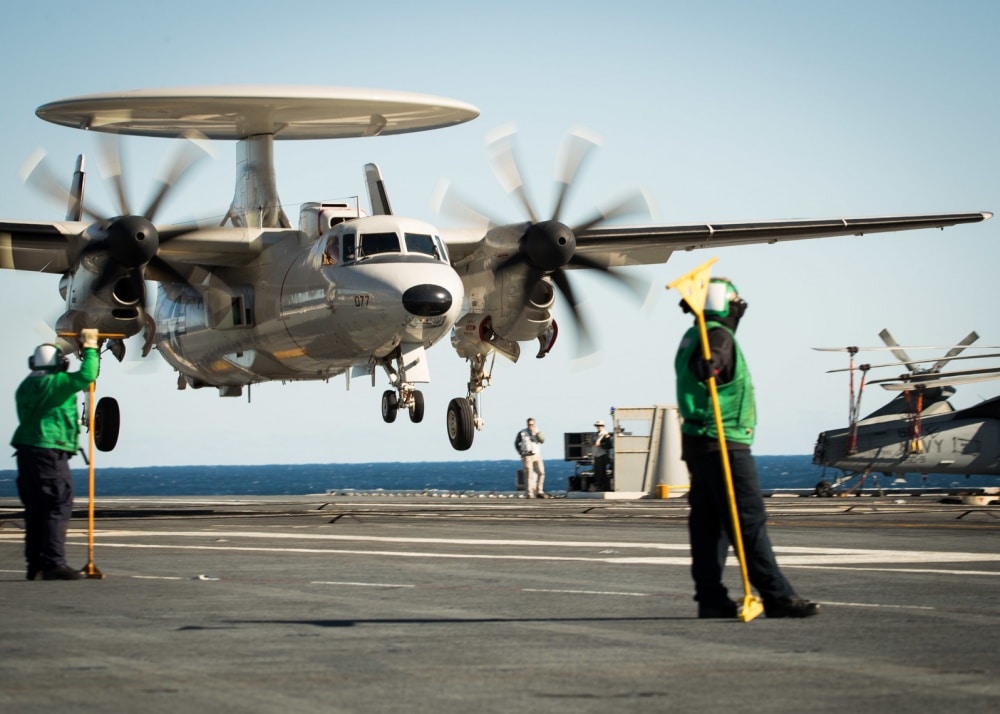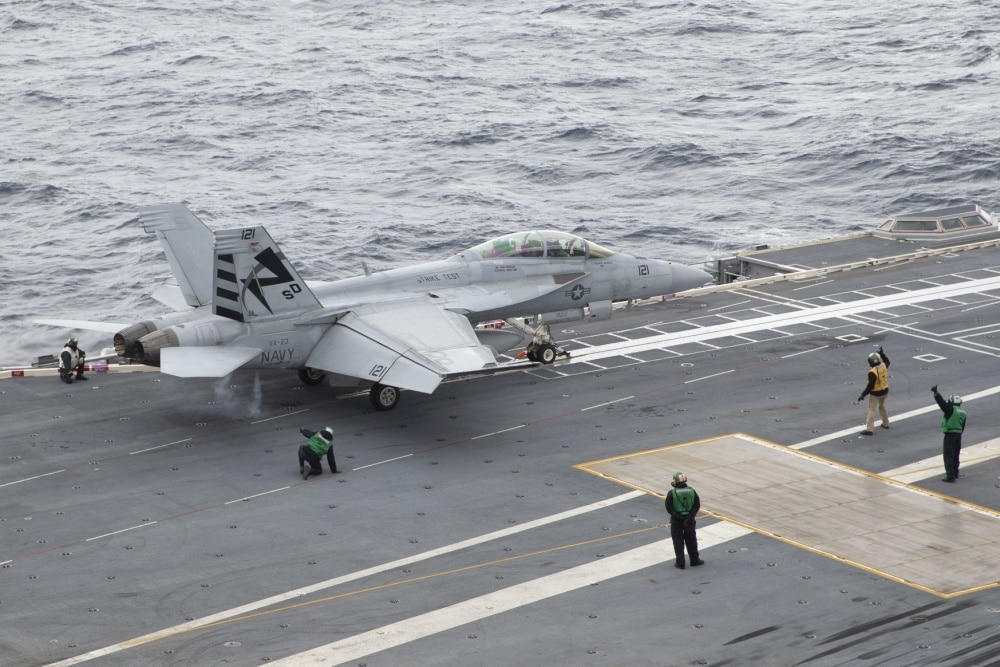Against a blistering 56 mph wind, an F/A-18F Super Hornet laden with fuel roared off the flight deck of the aircraft carrier Gerald R. Ford and into the brilliant January sky.
No glitches.
Chalk up another step forward for America’s newest and most expensive warship.

An F/A-18F Super Hornet, assigned to Air Test and Evaluation Squadron (VX) 23, takes off from USS Gerald R. Ford’s (CVN 78) flight deck. Ford is currently conducting Aircraft Compatibility Testing to further test its Electromagnetic Aircraft Launch Systems (EMALS) and Advanced Arresting Gear (AAG). (U.S. Navy photo by Mass Communication Specialist 2nd Class Ruben Reed)
The Ford has been at sea since Jan. 16, accompanied by Navy test pilots flying a variety of aircraft. They’re taking off and landing on the ship’s 5 acre flight deck, taking notes and gathering data that will prove valuable for generations of pilots to come.
The Navy calls it aircraft compatibility testing, and the process marks an important new chapter for a first-in-class ship that has seen its share of challenges.

An EA-18G Growler, assigned to Air Test and Evaluation Squadron (VX) 23, prepares to land aboard USS Gerald R. Ford’s (CVN 78) flight deck. Ford is currently conducting Aircraft Compatibility Testing to further test its Electromagnetic Aircraft Launch Systems (EMALS) and Advanced Arresting Gear (AAG). (U.S. Navy photo by Mass Communication Specialist 2nd Class Ruben Reed)
“We’re establishing the launch and recovery capabilities for the history of this class, which is pretty amazing,” said Capt. J.J. “Yank” Cummings, the Ford’s commanding officer. “The crew is extremely proud, and they recognize the historic context of this.”
Hampton Roads residents should see the Ford going back and forth from Naval Station Norfolk on a regular basis through this year and part of 2021. The ship is in the third month of an 18-month testing period and will be at sea about half that time.

A C-2A Greyhound, assigned to Air Test and Evaluation Squadron (VX) 20, approaches USS Gerald R. Ford’s (CVN 78) flight deck. Ford is currently conducting Aircraft Compatibility Testing to further test its Electromagnetic Aircraft Launch Systems (EMALS) and Advanced Arresting Gear (AAG). (U.S. Navy photo by Mass Communication Specialist 3rd Class Ryan Carter)
This current at-sea period should last into early February.
Besides the Super Hornet, pilots are flying the T-45 Goshawk, a training aircraft; the E/A-18G Growler, a specialized version of the Super Hornet that provides tactical jamming and electronic protection for other aircraft; the E-2D Advanced Hawkeye, with its signature disc-shaped array that is a common sight in the skies over Norfolk, and the C-2A Greyhound, which carries supplies, mail and passengers.

Sailors assigned to USS Gerald R. Ford’s (CVN 78) air department move an EA-18G Growler, assigned to Air Test and Evaluation Squadron (VX) 23, on the ship’s flight deck. Ford is currently conducting Aircraft Compatibility Testing to further test its Electromagnetic Aircraft Launch System (EMALS) and Advanced Arresting Gear (AAG). (U.S. Navy photo by Mass Communication Specialist 3rd Class Connor Loessin)
Each aircraft is different, and there is much to test, starting with the ship’s new launch and recovery systems.

A E-2D Hawkeye, assigned to Air Test and Evaluation Squadron (VX) 20, approacshes USS Gerald R. Ford’s (CVN 78) flight deck. Ford is currently conducting Aircraft Compatibility Testing to further test its Electromagnetic Aircraft Launch Systems (EMALS) and Advanced Arresting Gear (AAG). (U.S. Navy photo by Mass Communication Specialist 3rd Class Ryan Carter)
The Ford employs electromagnetic catapults to shoot aircraft off the flight deck, which famously prompted the ire of President Trump, who complained it was too complex. The Navy has stuck with the new system, called EMALS, which stands for Electromagnetic Aircraft Launch System.
To allow aircraft to safely land, Ford employs an Advanced Arresting Gear that uses a waterwheel/paddle system. Both AAG and EMALS have had well-documented growing pains, but are designed to provide smoother operation and reduce stress on aircraft.

An MH-60S Sea Hawk helicopter, assigned to the “Tridents” of Helicopter Sea Combat Squadron (HSC) 9, approaches USS Gerald R. Ford’s (CVN 78) flight deck, as an F/A-18F Super Hornet, assigned to Air Test and Evaluation Squadron (VX) 23, prepares to launch during flight operations. (U.S. Navy photo by Mass Communication Specialist Seaman Apprentice Angel Thuy Jaskuloski)
Pilots also have to deal with burble.
Webster’s dictionary defines “burble” as the separation and breakup of the streamlined flow of air. The Ford’s island is smaller and positioned farther to the rear of the ship than a Nimitz Class carrier. That changes how air flows across its flight deck, and pilots must document the effect.

A Sailor assigned to USS Gerald R. Ford’s (CVN 78) air department, watches over the wheel chocking of an MH-60S Sea Hawk helicopter, on Ford’s flight deck during flight operations. (U.S. Navy photo by Mass Communication Specialist Seaman Jesus O. Aguiar)
Test pilots say they’re enjoying the new experience.
“The approach to the ship is different, and everything underneath you is completely different,” said Cmdr. Eric Thurber.

An F/A-18F Super Hornet, assigned to Air Test and Evaluation Squadron (VX) 23, prepares to launch off USS Gerald R. Ford’s (CVN 78) flight deck. (U.S. Navy photo by Mass Communication Specialist Seaman Jesus O. Aguiar)
Thurber couldn’t go into great detail about the data being collected, but said it’s “kind of neat” to move from a land-based test site at Lakehurst, New Jersey, to flying at sea.
The work will continue after the ship returns to Norfolk said Cmdr. Mehdi “Metro” Akacem, the ship’s air boss, who is responsible for all aspects of operations involving aircraft.
“They’re here to do an evaluation, and that evaluation doesn’t end when the flying ends,” Akacem said. “There’s lots of technical analysis, not just on board. There is a large supporting cast of technical experts and engineering that is going to have a lot of data to analyze.”
Meanwhile, work continues on the ship’s wonky weapons elevators that transport ordnance up to the flight deck.
Like EMALS and AAG, the weapons elevators employ new technology, an electro-mechanical system that’s different from Nimitz Class ships. But in this case, the technology isn’t the problem. It’s finishing the construction to the point where the elevators operate smoothly over hundreds and hundreds of repetitions and between several decks.
Four of the ship’s 11 elevators have been certified, and work continues on the others. To that end, about 200 employees of Newport News Shipbuilding accompanied the crew on this trip.
All this testing and work has an important side benefit: the crew’s morale is sky high. After months and months at the Newport News shipyard or visiting the land-based testing sites in New Jersey, Ford’s sailors are finally where they want to be.
“We’ve got to just do the thing,” Akacem said. “That’s where we are right now. And that’s what’s so great about this moment. We’re out here doing the thing we’re built to do. And we’re learning so much every day.”
The $12.9 billion warship has been the subject of countless news stories and congressional hearings. Packed with new technology, it has met with significant setbacks since the Navy awarded a construction contract to the Newport News shipyard in 2008.
Was there a point when the Ford turned the corner?
Rear Adm. Jim Downey has been overseeing the Navy’s aircraft carrier program for only six months, but he saw a definite reversal of fortune in the latter half last year, when the Ford’s post-shakedown period was extended by three months at Newport News.
“We went to a seven-day-a-week approach and really held all of us accountable,” he said.
As progress was made on the elevators, “it really positively affected the morale of everybody working on the ship,” Downey said.
Then came sea trials, and the ship performed well.
“The crew has really taken ownership of it,” Downey said. “And you can see the difference. … I can in just the six months I’ve been here. The members of the crew and the workers, they’re energized.”
___
© 2020 the Daily Press
Distributed by Tribune Content Agency, LLC.



